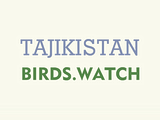search
classification
|
basic information
|
video
|
reports |
Cetti's Warbler
Cettia cetti (Temminck, 1820)

|
 adult
|
|
|
2019-09-05
Bar-Bulak |
© Philippe Campeau
|
|
Description
The Cetti's Warbler is less than Sparrow. The upperparts are olive-brown; underparts are brownish, abdomen is dirty-white. It resembles Reed Warblers by the image and behavior, but has more heavy constitution and the broad rounded tail which often is cocked. It is distinguished from the Nightingale by the broad tail and expressed but not bright supercilium. The bill is rosy-brownish, the base of lower mandible is yellow. Both sexes are similar. The autumn fresh plumage is same but upperparts are brighter, more buffy; underparts are greyer. Juveniles are similar on adults but the first plumage is softer with slightly expressed light mottles on upperparts; the flanks of the upper mandible are yellow (on adults upper mandible is all dark). The wings form: first primary is broad and long, longer than coverts more than 10 mm; the 4th and 5th primaries are longest of all. Weigh 11-19 grams, length about 14, wing 5,9-6,9, wingspan 15-19 mm.
Biology
The Cetti's Warbler is common, in places rare breeding migrant. It inhabits the bush thickets on shores of steppe rivers, lakes and ponds; riparian forests; reed beds with shrubs; on plains and in foothills up to 750 m. On migration it occurs in same places, and very rare in forest-belts. It arrives early, in March – early April. Birds all the time keep in the dense bushes and reeds; more often it is possible to see only the dark bird has flashed in thickets. It is very mobile. Breeds in separate pairs. Nest is built in the bush or on the ground in dense thickets; from the grass, leaves, rootlets and is lined with thin grass and rare with some hair and feathers. Most often the bulky cup-shaped nest is unavailable. The nest is not attached to branches and stalks, but only leans to them. Clutches of 4-5 eggs is in May – early June. The eggs are rusty-reddish. A brood of fledglings observed in mid-June. The nestlings leave the nest not being able to fly, but well climbing onto the branches and the vertical stalks of grasses. Male stops to sing in end July – mid-August. Autumn migration is late, latest birds recorded in late November.
References
Gavrilov E. I., Gavrilov A. E. "The Birds of Kazakhstan". Almaty, 2005. Э.И.Гаврилов. "Фауна и распространение птиц Казахстана". Алматы, 1999. В.К.Рябицев. "Птицы Урала, Приуралья и Западной Сибири". Екатеринбург, Изд-во Уральского университета, 2000.










